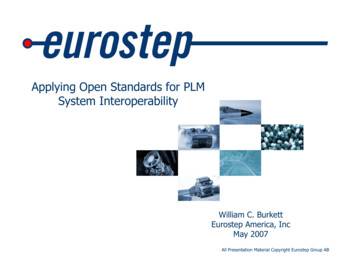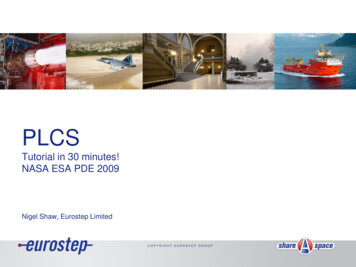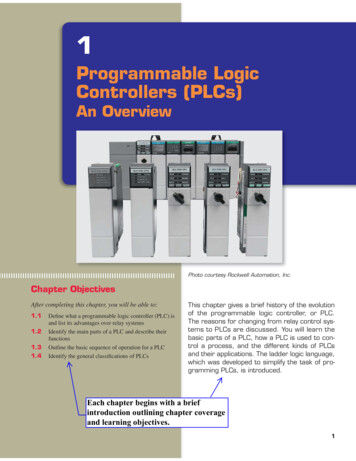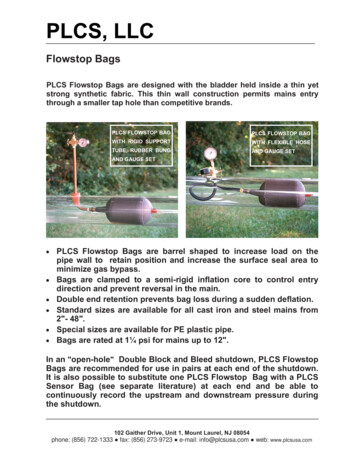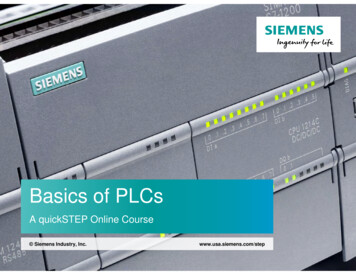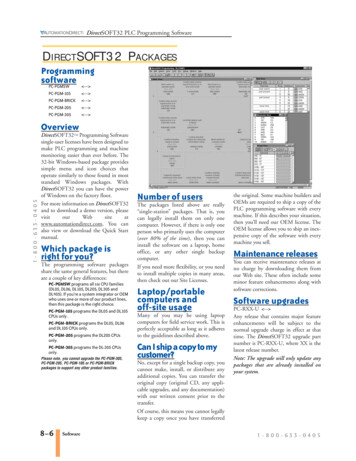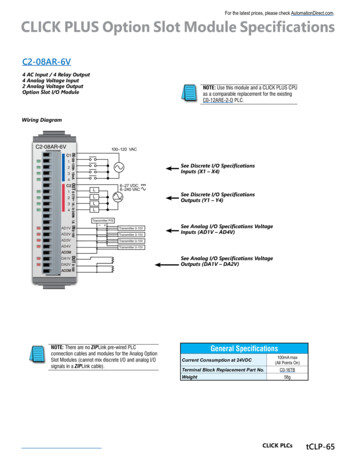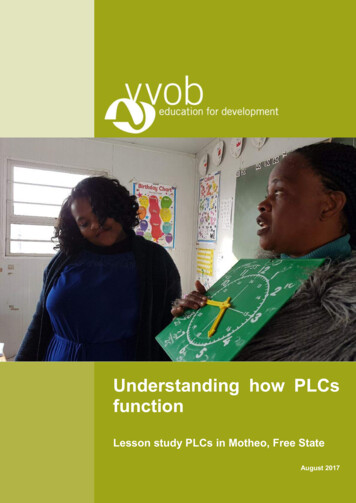
Transcription
Understanding how PLCsfunctionLesson study PLCs in Motheo, Free StateAugust 2017
Content1.Background 32.Methodology 33.2.1Data collection 32.2Data analysis 32.3Respondents observations and focus group discussions 3Findings 43.1PLC Characteristics 43.2Mutual trust and respect 53.3Relevance in practice 63.4Leadership 73.5Inclusive membership 83.6Collaboration to reach all learners 93.7Regularity 124.Conclusion 135.Recommendations for data collection tools 146.References 14Understanding how PLCs function – lesson study PLCs in Motheo, Free State2/14
1. BackgroundVVOB and FSDOE support subject advisors and teachers in Botshabelo, Motheo district in engaging with lessonstudy activities in the format of a PLC in the period February-October 2017. The focus of the lesson study sessionsis to target all learners and hence promote differentiation and inclusive practices. VVOB entered in acollaboration with Jika Communication & Training to steer the lesson study.Ten schools are selected in collaboration with FSDOE to engage in the lesson study PLCs. Two lesson study groupsare selected per school, one for foundation phase and one for intermediate phase. This means that there are 20PLCs in total.VVOB conducted a study on a selection of PLCs to collect baseline information on the functioning and outcomes of PLCs for improved learning andteaching; pilot the data collection tools, which will be used to conduct the evaluation of the 12 PLCs which will bepromoted with support from EU.2. Methodology2.1 Data collectionData were collected in the form of A rubric for PLC observations. The rubric is built on the ten characteristics of an effective PLC, in linewith the DBE PLC guidelines (DBE, 2015). The observations will give insights into the characteristics ofPLCs and implications on their functioning. Focus group discussion guidelines. After each PLC observation, a focus group discussion was organisedto further explore the ‘status’ of the PLC characteristics and the effectiveness of the PLC sessions toimprove inclusive teaching practices.2.2 Data analysisQualitative data analysis was applied to the focus group data and rubric observation data, using the constantcomparison method. After open coding the data, consistencies and differences were searched for resulting inthe development of categories, linked to the characteristics of a PLC.2.3 Respondents observations and focus group discussionsData were collected from 5 of the 20 PLCs (3 Foundation Phase, 2 Intermediate Phase) during the 2nd PLC sessions.In total, there are 4 PLC sessions guided by Jika and mentored by district officials per PLC.Number of PLC members (session 2)121086420IP Pontsheng FP Dibeng sa FP Pontsheng IP Tlhlolo PSPSTsebo PSPSFP Tlhlolo PSOn average, there were 6 members per consulted PLC in these sessions. All PLC members were female.Understanding how PLCs function – lesson study PLCs in Motheo, Free State3/14
3. Findings3.1 PLC CharacteristicsAnalysing the ten characteristics of a PLC, according to the PLC guidelines from DBE (2015), the observed PLCsare in a developing stage. The PLCs seem to be coherent and responsive to changes in practice, compared toone-off forms of professional development. This can be explained by the activity engaged in in the PLCs. Theactivities addressed in the PLCs focus on lesson study. PLC participants collaboratively develop lesson plans,observe each other and give feedback on the lessons presented. These activities allow the PLC members to applywhat was learned in their practice. The observed PLCs tend to be in a start-up phase to develop a shared visionand to have an inclusive membership.PLC characteristics based on Phases (1 starting out/low level, 4 sustained/high level)3,532,521,510,50FPIPComparing the Foundation Phase (FP) with the Intermediate Phase (IP) PLCs, largest differences appear in theinclusive membership and regularity of the PLCs. The IP PLCs tend to be more inclusive than PLCs with FPteachers. The latter tend to be closed groups with limited room for external viewpoints. Whereas IP PLCs seemto stimulate the input of external viewpoints to increase diversity and learning in the PLC. Leadership in the PLCswith FP teachers is mostly taken up by the HoD. A possible explanation is the fact that FP teachers teach in themother tongue. Communicating feedback in English in a PLC makes them less confident and possibly lessarticulate compared to the PLCs with IP teachers. Observations of the FP PLCs give indications it is likely thesePLCs will continue working together to further explore the topics discussed. Such indications were not identifiedin the IP PLCs.In the next section, we will have a closer look at each PLC characteristic as described in the DBE guideline onPLCs.Understanding how PLCs function – lesson study PLCs in Motheo, Free State4/14
3.2 Mutual trust and respect70%60%50%40%30%20%10%0%60%40%0%Members highlight issuesA moderate level ofaround trust and conflict. mutual trust exists amongA blame culture may exist. members. Although thereDevelopment issues areis some anxiety aboutviewed as a threat by aclassroom observationnumber of staff.etc.0%Trust, respect and positive Member relationships areprofessional relationshipscharacterised byare developing in the PLC.openness, honesty,Members are increasingly mutual trust, respect,open about their practice.support and care.Everyone’s contribution isvalued.Most PLCs have a moderate level of mutual trust among the members with some indications of anxiety to openup their practice. This anxiety stemmed from being unprepared for the PLC session or from the fact of beingobserved:“It’s not often that there is someone in class when I’m teaching.” (Pontsheng FP)“We were not expecting visitors and then the other lady who was supposed to prepare was sick, so we werenervous.” (Dibeng sa Tsebo FP)Especially in the FP PLCs, teachers were open and gave feedback in a respectful and professional way. This canbe explained by the fact that the teachers in the PLCs knew each other and felt comfortable in the PLC. Butcreating this trust takes time.“Because we know each other as we come from the same phase in the school, we also are familiar with eachother.” (Dibeng sa Thebo FP)“In our PLC we feel free and we trust each other. We are happy to learn from each other. Although some laughwhen you make a mistake, we are encouraging them to stop it so that we don’t lose confidence.” (Thlolo FP)“Some are not discussing a lot because they are still new.” (Thlolo FP)Another contributing factor for mutual trust is the fact that teachers are getting used to the PLC concept:“We also have another PLC in our cluster which involves other schools as well. We are getting used to the idea.”(Dibeng sa Thebo FP)One of the PLCs stressed the importance of team spirit in working together to improve their teaching. They reliedon each other and assisted each other.“We have created a foundation for a strong team. We want to encourage each other and not lose members. Wewill encourage each other when we feel that we are losing the spirit and strength to continue.” “Also our teamspirit encourages us. We know we are not perfect and we want to develop ourselves.” (Thlolo FP)Understanding how PLCs function – lesson study PLCs in Motheo, Free State5/14
3.3 Relevance in practiceData collected for the following two characteristics informed how relevant the PLC sessions were for applicationinto practice: Systematic, rigorous enquiry into practice Coherent, responsive change in practiceSystematic, rigorous enquiry into practice70%60%60%50%40%30%20%20%20%10%0%0%There is little reflection orSome members areMany members are actively A questioning orientationinvolved and showenquiry into practice. Data involved in activities toto practice and ‘need toincreasing confidencecollection and the use of investigate and improveknow how we are doingabout using different and how we can improve’ isdata to inform and develop learning and teaching (e.g.learning and teaching peer observation, coaching, methods to explore andpervasive. Membersaction research). Dataimprove learning andpractice are limited. Dataconfidently use a widemay be seen as an end in collection and the use of teaching. Data collectionrange of methods toitself and often as someone data to inform and develop and the use of data toinvestigate learning andlearning and teaching areinform and developelse’s problem.teaching, using findings tovariable.learning and teaching are inform and develop theirincreasingly consistent.practice. DataCoherent, responsive change in re is little feedbackSome members discussand learn newand reflection fromapproaches, but aremembers on each other’spractice. There is no link hesitant to apply it in theirpractice and sharebetween the PLC andchanges in teaching and outcomes in the PLC. ThePLC is seen as a one-offlearning.form of professionaldevelopment, with noclear link toimplementation intopractice.Members increasinglyDiscussing, learning anddiscuss and learn new applying and reflecting onapproaches, apply it in new approaches is takentheir practice and reflectfor granted. Theseon it in the PLC.discussions are followedup by monitoring thepractice, for examplethrough lessonobservations and erroranalysis, enhancingcoherence in professionaldevelopmUnderstanding how PLCs function – lesson study PLCs in Motheo, Free State6/14
All observed PLCs showed evidence of teachers sharing viewpointson (new) teaching strategies in their classroom practice. Teachersdiscussed these approaches thoroughly from a practical point ofview. This can be explained by the activities engaged in in thesePLCs. Lesson study involves preparing lesson plans, observing eachother’s lessons and giving constructive feedback. This approachhelps teachers to apply it in their practice and to reflect on it in thenext PLC session. No data were consulted from personal or nationwide assessments.“It is easy to come up with a good lesson plan that accommodates learner diversity if you do it in a PLC.” (ThloloIP)“I learnt how best I can use the follow me card in fractions.” (Thlolo IP)3.4 eadership in the PLC isOther members areLeadership within the PLC Distributed leadershiptaken up by an external involved in leading some is increasingly taken up by among members is anactor (e.g. subject advisor,PLC activities.different members.accepted practice.Bothlearning support advisor)males and females take upor by one member in aleadership functions, suchtop-down way.as setting the agenda,developing resources,coordinating groupactivities, supportingcolleagues’ learning.The external facilitator had an active leadership role in most observed PLCs, but mostly in combination withexamples of distributed leadership amongst the teachers. The latter involved leading the discussions during andafter the lesson observations, timekeeping and recording the discussion observations.“We think we could continue on our own even after Ria [external facilitator] has gone.” (Dibeng sa Tsebo FP)“Although it took some time to have a person to lead the proceedings but we finally had a chairperson, scriberand presenter.” (Thlolo IP)In one PLC, a teacher was selected to act as the facilitator but she was not ready to do so leading to the externalfacilitator guiding the discussions.The role of the external facilitator focused on enriching the discussion, for instance by ensuring that the lessontargets all learners in class. The external facilitator is perceived as a good motivator for the PLC.“Ria [external facilitator] also motivates us. When we came to the first session we were angry because we hadnot been informed on time. We were told on the very day that we were meeting and it was a Monday which wasnot good. Then later when we sat down with Ria, the way she did her thing made us like it and from then on weliked it. We enjoy it now; we even make it more practical by having learners in the demos. Ria also makes us feelUnderstanding how PLCs function – lesson study PLCs in Motheo, Free State7/14
proud to be teachers and says we can be proud like other professionals whether they are lawyers or doctors.”(Dibeng sa Tsebo FP)“She [external facilitator] is dedicated, she puts much effort and strength. She made us see that this is not awaste of time.” (Pontsheng FP)The DBE guideline on PLCs (2015, p.7) states that “supportive school management is a major condition foreffective PLCs”. Teachers from two PLCs indicated that they are satisfied with the support they receive fromtheir SMT.“Our principal and deputy motivate and support us.”“The principal is supportive because he has allowed the PLC to take place in the school.”“Our HoD also takes part in the lesson study PLC so we feel that the idea is supported.”In two other PLCs, support from the SMT was absent. Teachers feel the schools are not providing sufficientresources for the PLC. One PLC mentioned that the HoD doesn’t show interest in the PLC sessions.3.5 Inclusive membership70%60%60%50%40%30%20%20%20%10%0%0%The PLC is a closed groupwhich doesn’t allow forother teachers to join orfor external viewpoints tobe taken into account.There is limited diversityin viewpoints.An increasing number ofmembers are stimulatingdiversity in the PLC. Theinput of other viewpointsis not yet leading toeffective learning withinthe PLC.The PLC is increasingly The diversity within thestimulating diversity toPLC helps creating aincrease effectivestimulating learninglearning. Other teachersenvironment. This isare stimulated to join the underlined by some of thePLC. External viewpoints following examples. Theare increasingly taken intoPLC is open to newaccount.members. Steps are takento make sure the PLC hasa gender balancedrepresentation. The PLCformsGiven the activities of the PLCs, the observed PLCs are mostly a closed group. The lesson study cycle requeststhe same teachers to work on specific activities. Moreover, an external facilitator was present in all PLCs bringingin expertise and alternative viewpoints. Two PLCs would like to open up their membership to enrich the PLC:“We could want others to come so as to get other viewpoints as it could lead to growth and development. Wewant both negative and positive viewpoints.” (Pontsheng FP)“We like external visitors like yourself. Your questions are opening up our eyes to some things we did not thinkabout.” (Thlolo FP)“Commitment and participation of senior managers, e.g. subject advisors, is very important so that they can giveguidance on other matters.” (Pontsheng IP)“It [the PLC] should include other school’s bodies to improve the quality of the deliberations.” (Pontsheng IP)Understanding how PLCs function – lesson study PLCs in Motheo, Free State8/14
“We need more assistance from external experts to assist us with lesson plans. As you can see that Ria and hercolleagues are helping us a great deal.” (Thlolo IP)In one PLC, new members joined in the second session, which implicated the efficiency of the PLC. New membersneeded time to get familiar with the concept and were hesitant to speak up during discussions. Teachers werenot sure whether it was wise to get others to join the PLC when it had already made some progress. If otherteachers joined now, they felt that they might not be able to cope. However, other teachers felt that newteachers could also benefit of being members by listening and observing what happened in the PLC.In all observed PLCs, all members were female.3.6 Collaboration to reach all learnersData collected for the following four characteristics give indications on how teachers collaborate with each otherto improve their teaching to reach all learners: Collaborative and reflective enquiry Collective responsibility for student learning Shared vision and focus on learning for all learners Support challenge and constructive critiqueCollaborative and reflective enquiry / collective responsibility forstudent g, teaching andSome members are openingMembers are increasinglyAll members are havingassessing learners remains up their classrooms throughengaging in thoroughthorough conversations aboutthe individual task of every peer learning, team teaching, conversations about their their teaching and learning.member in the PLC.observations and/orteaching and learning through They examine their practiceClassrooms remain closed for mentoring. This leads to initial peer learning, team teaching, through mutual observationother teachers.conversations about theirobservations and/orand case analysis, jointteaching and learning.mentoring.planning and applying newideas and information to gaina deeper understanding ofeducationalIn most PLCs observed, teachers planned the lesson together and discussed different teaching strategies. Lessondemonstrations were done with consecutive discussions showing that teachers are learning from each other.“That lesson taught us that when we work together you can overcome the problems you have in class. Practicalexamples play a major role in problem solving. Learners cannot forget the lesson because of the experientialpart, eg, the taxi drive role play that was used in the lesson. We learn from each other.” (Dibeng sa Tsebo FP)Understanding how PLCs function – lesson study PLCs in Motheo, Free State9/14
“The PLC influences us a lot in our practice. Teachers can learn differentthings from each other. For example, if one teacher is not confident inteaching division, then another in the group is good at that then you canlearn from them. We are influenced by each other because we can see anddiscuss the lesson plans together. We can see how others do things and welearn especially in the practical demonstrating of lessons. Collaboration withothers helps as we get different ideas.” (Dibeng sa Tsebo FP)“It was a nice experience as it is good to have colleagues as they can helpwhere you lack. I believe it is a good way for development. I learnt fromobserving the others, eg, the way she (one of the teachers) assessed thelearners. It has a good influence on our practice as we learn from each otherand share ideas. Also how to keep time. We take from each other differentstrategies. There is personal growth coming from each other.” (PontshengFP)“We learn different teaching styles from each other, we are learning about each other, we are building a team.”“'We feel free, we develop team spirit amongst ourselves.” “When your learners are struggling we now know wecan check with our colleagues for assistance.” (Thlolo FP)In one PLC, not all members were contributing to the discussions and some remained silent. Some teachers feltthat others were not contributing fully all the time because of different personalities.“We are different and sometimes some people do not share as easily as others.”These PLC characteristics are closely related to the need for a shared vision, focus on learning for all learners andsupport challenge and constructive critique in a PLC.Shared vision and focus on learning for all learners70%60%60%50%40%40%30%20%10%0%0%0%The group has diverse values An increasing number of Educational values and vision Educational values and visionare spread and regularlyrelated to educational issues. members share educational are shared and sometimesvalues, and participatedemonstrated throughrevisited and revised andThey are beginning torecognise the need to move actively in discussions about practice. Learning and not consistently demonstratedvision and values.teaching is the focus ofthrough practice. Learningtoward some collaborativeeducation.and not teaching is the focusprocesses. There may beof education.initial discussions aboutlearners’ learning, work andinstructional practice.Understanding how PLCs function – lesson study PLCs in Motheo, Free State10/14
Support challenge and constructive tique is not perceived Some member perceive Members are increasinglyas constructive. Ideas andcritique from otherappreciating constructivequestions are hampering members as constructive, critique. Challenging eachdevelopmentalwhile other members face other is increasinglyconversations andchallenges in appreciatingperceived as part oflearning.critique. Disagreementlearning together.between the members isnot always leading tolearning.Constructive critique isinvited and appreciatedby all PLC members andby doing so, memberslearn and align their ideason learning. Disagreementis a natural part of thegroup interaction and thediversity of perspectivesprovide a fruitful soil forleaBy giving feedback on each other’s lessons, PLC members share successes and shortcomings and explore what itmeans for their teaching in their classrooms. This reflective attitude and collaboration increases the confidenceof teachers as they are all working towards the same objectives and share the effort.“When we sat down and put all our ideas on the table in the PLC, we got more comfortable with each other. Wewere now concentrating on the work we were doing.” (Dibeng sa Tsebo FP)“When we share, the burden becomes better.” (Pontsheng FP)“If I don’t know something or have challenges in class, I can come and share the challenge in the PLC.” (PontshengIP)“Even though we never met as a PLC due to time constraints, but as you have observed, we are free to openlycriticise one another with the hope of providing our kids with quality education.” (Thlolo IP)In most observed sessions, members perceive critique as constructive. Members relate discussions to their ownpractice and have honest discussions. In one PLC session, some members didn’t feel comfortable to expressthemselves.Understanding how PLCs function – lesson study PLCs in Motheo, Free State11/14
3.7 here are no indicationsThere are someThere are indications that There are clear indicationsthe PLC comes together indications that some PLC most PLC members willthat the PLC is comingregularly or that the PLC is members will continue continue working together together regularly and isfollowed up byworking together toto further explore thecommunicating in(electronic)further explore thetopic(s) discussed.between the sessions tocommunication.topic(s) discussed.achieve deep discussions,gains in knowledge andsustainable effects.It is not yet clear from these second sessions if the PLCs will continue beyond the lesson study cycle. It is likelythat a core group of selected PLCs members might continue the sessions. As discussed above, this is more likelyfor the members of FP PLCs. The members are so highly engrossed in their discussions that they seem to continuethese discussions even outside the mentored lesson study sessions.“We think we could continue om our own even after Ria has gone.” “We will see after the fourth session whetherthere were enough sessions. We have not had a dropout from our group.” (Dibeng sa Tsebo FP)The biggest challenge is the timing of the PLC. As teachers are still quite new to the PLC concept, it takes time toprepare and engage in the sessions.“We are still at the starting stage. Maybe when we get more experience, we can do more in a short time.” (Dibengsa Tsebo FP)“The time is not enough and we are already tired after teaching. Maybe we could have more time during schooltime and then we could replace it later.” (Pontsheng FP)“The lesson study is good but we have no time to do it properly.” “We are marking exam scripts so the time isvery limited to do the work preparing for the lesson study.” (Thlolo FP)“Because of time constraints our colleagues are not prepared to join the PLC. The challenge that we have that isa stumbling block is time allocated for PLC meetings.” (Thlolo IP)Understanding how PLCs function – lesson study PLCs in Motheo, Free State12/14
4. ConclusionThe PLC characteristics defined in the DBE guideline on PLCs provide a framework of assumptions of wellfunctioning PLCs. The data collected from the lesson study PLCs in Motheo district in Free State, help tounderstand how PLCs function as a method for continuing professional development and how their effectivenesscould be improved.A safe environment where all PLC members know and trust each other is an indicator for the quality of thediscussions in a PLC. This is confirmed by Stoll et al. (2006, p.239) who states that “teachers are unlikely toparticipate in classroom observation and feedback, mentoring partnerships, discussion about pedagogical issues,curriculum innovation, unless they feel safe”. Opening your classroom practice can come with anxiety, unlessyou trust your colleagues. The role of an external facilitator is delicate in that regard. On the one hand, anexternal facilitator might hamper the trust and safe environment in a PLC, because he or she can be perceivedas an intruder in that environment. But the external facilitator was also a key motivator for the PLCs in this study.The role of the external facilitator was to enrich the discussions and increase the relevance of the PLCs by bringingwhat is learned into practice. Research from Murphy (2015) confirms this observation by stating that thepresence of formal leaders in the creation of learning communities is paramount.This brings us to leadership. In the observed PLC sessions, an external facilitator was taking up the leadershiprole of the PLC. But some PLCs gave indications of distributed leadership, where different members were takingup leadership functions such as leading the discussions, timekeeping and recording the exchanges. This is animportant step to ensure the sustainability of the PLC beyond the presence of the external facilitator. In someobserved PLC sessions, instructional leadership and support from management for the PLCs was present, but inother PLCs this was absent. The role of leadership should be supportive and developmental rather than focusingon accountability as a result of provincial or national policies. School leadership can nurture PLCs and providethe necessary resources, but should not impose PLC structures in the school. “Accountability imposed fromoutside a PLC – usually stemming from a top-down, albeit worthy initiative – does not lead to the most effectivePLCs” (Brown Easton, 2016, p. 44).PLCs are a method of collective learning where participants determinetheir own professional development. In most PLCs, participantsacknowledged that by sharing the effort, they become better teachers.Teachers learn teaching strategies from each other and test out whatworks best in their class. In the lesson study PLCs, an experientialteaching strategy was introduced by giving practical examples forproblem solving. This teaching strategy helped participants to improvethe quality of their teaching so that their learners would understand thetopic better. Constructive critique is increasingly appreciated by the PLCmembers and challenging each other is perceived as part of learningtogether. This relates closely to the need or a safe and trustfulenvironment amongst PLC members. When you trust your co-worker,you will more easily accept feedback and learn from each other.Although peer learning is the focus of a PLC, external support wasrequired in the observed PLCs to bring in alternative viewpoints. The PLCswere mostly closed groups, with a fixed number of teachers, but theyacknowledge that by bringing in external visitors, the quality of theirdiscussions will improve. This is a role that could be taken up by HoDs or district officials like subject advisors.The type of activity engaged in in these PLCs increased the applicability of what was learned in practice. Lessonstudy focuses on real lesson preparations, implementations and observations, increasing the relevance of thePLCs. The outcomes of the PLCs relate closely to the daily practice of the teachers. This makes the PLC methodmore responsive to changes in practices compared to other forms of professional development, like workshopsor trainings.The sustainability of the PLC sessions highly depends on the characteristics discussed above. But mostimportantly, the benefits as perceived by the PLC members must outweigh the time invested in the PLCs. Clearcommunication about the benefits of a PLC could help in this regard: “We needed more info on the PLC beforeothers were told they could leave if they wanted. I think some left the PLC because they did not fully understandhow they could benefit from it or what it really was about.” (Thlolo FP)Understanding how PLCs function – lesson study PLCs in Motheo, Free State13/14
5. Recommendations for data collection toolsFrom the implementation of the data collection tools, it is recommended to make the following changes to thePLC observation rubric: To combine the benchmarks of the characteristics on collaborative and reflective enquiry and col
Understanding how PLCs function - lesson study PLCs in Motheo, Free State 4/14 3. Findings 3.1 PLC Characteristics Analysing the ten characteristics of a PLC, according to the PLC guidelines from DBE (2015), the observed PLCs are in a developing stage. The PLCs seem to be coherent and responsive to changes in practice, compared to
